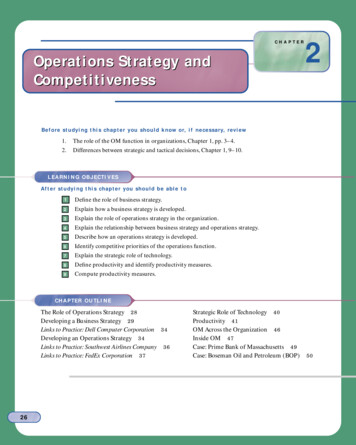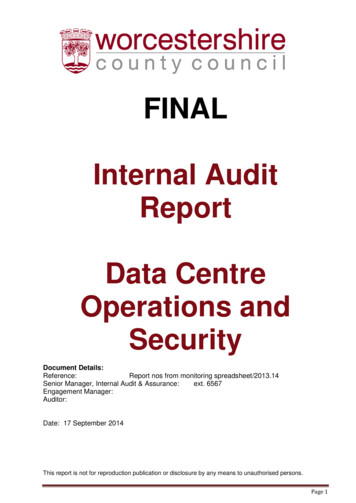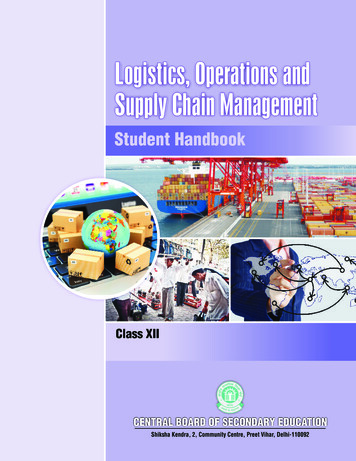
Transcription
CHAPTEROperations Strategy andCompetitiveness2Before studying this chapter you should know or, if necessary, review1.2.The role of the OM function in organizations, Chapter 1, pp. 3–4.Differences between strategic and tactical decisions, Chapter 1, 9–10.LEARNING OBJECTIVESAfter studying this chapter you should be able to123456789Define the role of business strategy.Explain how a business strategy is developed.Explain the role of operations strategy in the organization.Explain the relationship between business strategy and operations strategy.Describe how an operations strategy is developed.Identify competitive priorities of the operations function.Explain the strategic role of technology.Define productivity and identify productivity measures.Compute productivity measures.CHAPTER OUTLINEThe Role of Operations Strategy 28Developing a Business Strategy 29Links to Practice: Dell Computer Corporation 34Developing an Operations Strategy 34Links to Practice: Southwest Airlines Company 36Links to Practice: FedEx Corporation 3726Strategic Role of Technology 40Productivity 41OM Across the Organization 46Inside OM 47Case: Prime Bank of Massachusetts 49Case: Boseman Oil and Petroleum (BOP) 50
OPERATIONS STRATEGY AND COMPETITIVENESS 27o maintain a competitive position inthe marketplace, a company musthave a long-range plan. This plan needsto include the company’s long-termgoals, an understanding of the marketplace, and a way to differentiate itselffrom its competitors. All other decisions made by the company must support this long-range plan. Otherwise,each person in the company wouldpursue goals that he or she consideredimportant, and the company wouldquickly fall apart.The functioning of a football team onthe field is similar to the functioning of abusiness and provides a good example of the importance of a plan or vision. Before theplays are made, the team prepares a game strategy. Each player on the team must perform a particular role to support this strategy. The strategy is a “game plan” designed sothat the team can win. Imagine what would occur if individual players decided to doplays that they thought were appropriate. Certainly the team’s chance of winning wouldnot be very high. A successful football team is a unified group of players using their individual skills in support of a winning strategy. The same is true of a business.The long-range plan of a business, designed to provide and sustain shareholdervalue, is called the business strategy. For a company to succeed, the business strategymust be supported by each of the individual business functions, such as operations, finance, and marketing. Operations strategy is a long-range plan for the operationsfunction that specifies the design and use of resources to support the business strategy.Just as the players on a football team support the team’s strategy, the role of everyonein the company is to do his or her job in a way that supports the business strategy.Let’s look at two companies operating in the same industry, but with very differentbusiness strategies. The first is Southwest Airlines, which has a strategy to compete oncost. Southwest offers low-cost services aimed at price-sensitive customers. To support this strategy, every aspect of Southwest’s operation is focused on cutting costsout of the system. Later in this chapter we will look at specific operations decisionsthat Southwest has made to achieve this. The second company is Singapore Airlines,which has a strategy to compete on service. To support this strategy the airline offersfree drinks, complimentary headsets, meals prepared by gourmet chefs, comfortablecabins, and even the biggest bed in business class called the “spacebed.” Both airlinesbegan as regional carriers and each has grown to be a highly successful major airline.Although they are in the same industry, their operations decisions are differentbecause of their different business strategies.T Business strategyA long-range plan for abusiness. Operations strategyA long-range plan for theoperations function thatspecifies the design and useof resources to support thebusiness strategy.
28 CHAPTER 2OPERATIONS STRATEGY AND COMPETITIVENESSIn today’s highly competitive, Internet-based, and global marketplace, it is important for companies to have a clear plan for achieving their goals. In this chapter wediscuss the role of operations strategy, its relationship with the business strategy, andways in which the operations function can best support the business strategy. We conclude with a discussion of productivity, one measure of a company’s competitiveness.THE ROLE OF OPERATIONS STRATEGYHuman Resources, MISThe role of operations strategy is to provide a plan for the operations function so thatit can make the best use of its resources. Operations strategy specifies the policies andplans for using the organization’s resources to support its long-term competitivestrategy. Figure 2-1 shows this relationship.Remember that the operations function is responsible for managing the resourcesneeded to produce the company’s goods and services. Operations strategy is the planthat specifies the design and use of resources to support the business strategy. This includes the location, size, and type of facilities available; worker skills and talents required; use of technology, special processes needed, special equipment; and qualitycontrol methods. The operations strategy must be aligned with the company’sbusiness strategy and enable the company to achieve its long-term plan. For example,the business strategy of FedEx, the world’s largest provider of expedited deliveryservices, is to compete on time and dependability of deliveries. The operations strategy of FedEx developed a plan for resources to support its business strategy. Toprovide speed of delivery, FedEx acquired its own fleet of airplanes. To provide dependability of deliveries, FedEx invested in a sophisticated bar code technology totrack all packages.The Importance of Operations StrategyOperations strategy did not come to the forefront until the 1970s. Up to that time U.S.companies emphasized mass production of standard product designs. There were noFIGURE 2-1Business StrategyRelationship between thebusiness strategy and thefunctional strategiesDefines long-rangeplan for companyMarketing StrategyOperations StrategyFinance StrategyDefines marketing plansto support the businessstrategyDevelops a plan for theoperations function to supportthe business strategyDevelops financial plansto support thebusiness strategy
DEVELOPING A BUSINESS STRATEGY 29serious international competitors, and U.S. companies could pretty much sell anythingthey produced. However, that changed in the 1970s and 1980s. Japanese companies began offering products of superior quality at lower cost, and U.S. companies lost marketshare to their Japanese counterparts. In an attempt to survive, many U.S. companiescopied Japanese approaches. Unfortunately, merely copying these approaches oftenproved unsuccessful; it took time to really understand Japanese approaches. It becameclear that Japanese companies were more competitive because of their operations strategy; that is, all their resources were specifically designed to directly support the company’s overall strategic plan.Harvard Business School professor Michael Porter says that companies often donot understand the differences between operational efficiency and strategy. Operational efficiency is performing operations tasks well, even better than competitors.Strategy, on the other hand, is a plan for competing in the marketplace. An analogymight be that of running a race efficiently, but it may be the wrong race. Strategy isdefining in what race you will win. Operational efficiency and strategy must bealigned; otherwise you may be very efficiently performing the wrong task. The roleof operations strategy is to make sure that all the tasks performed by the operations function are the right tasks. Consider a software company that recently invested millions of dollars in developing software with features not provided bycompetitors, only to discover that these were features customers did not particularly want.Now that we know the meaning of business strategy and operations strategy andtheir importance, let’s look at how a company would go about developing a businessstrategy. Then we will see how an operations strategy would be developed to supportthe company’s business strategy.DEVELOPING A BUSINESS STRATEGYA company’s business strategy is developed after its managers have considered manyfactors and have made some strategic decisions. These include developing an understanding of what business the company is in (the company’s mission), analyzing anddeveloping an understanding of the market (environmental scanning), and identifyingthe company’s strengths (core competencies). These three factors are critical to the development of the company’s long-range plan, or business strategy. In this section, wedescribe each of these elements in detail and show how they are combined to formulate the business strategy.MissionEvery organization, from IBM to the Boy Scouts, has a mission. The mission is astatement that answers three overriding questions: What business will the company be in (“selling personal computers,” “operatingan Italian restaurant”)?Who will the customers be, and what are the expected customer attributes(“homeowners,” “college graduates”)?How will the company’s basic beliefs define the business (“gives the highest customer service,” “stresses family values”)? MissionA statement defining whatbusiness an organization is in,who its customers are, andhow its core beliefs shape itsbusiness.
30 CHAPTER 2OPERATIONS STRATEGY AND COMPETITIVENESSFollowing is a list of some well-known companies and parts of their missionstatements:Dell Computer Corporation: “to be the most successful computer company in theworld”Delta Air Lines: “worldwide airlines choice”IBM: “translate advanced technologies into values for our customers as the world’slargest information service company”Lowe’s: “helping customers build, improve and enjoy their homes”Ryder: “offers a wide array of logistics services, such as distribution management,domestically and globally”The mission defines the company. In order to develop a long-term plan for a business, you must first know exactly what business you are in, what customers you areserving, and what your company’s values are. If a company does not have a welldefined mission it may pursue business opportunities about which it has no realknowledge or that are in conflict with its current pursuits, or it may miss opportunities altogether.For example, Dell Computer Corporation has become a leader in the computer industry in part by following its mission. If it did not follow its mission Dell might decide to pursue other opportunities, such as producing mobile telephones similar tothose manufactured by Motorola and Nokia. Although there is a huge market for mobile telephones, it is not consistent with Dell’s mission of focusing on computers.Environmental Scanning Environmental scanningMonitoring the externalenvironment for changes andtrends to determine businessopportunities and threats.A second factor to consider is the external environment of the business. This includestrends in the market, in the economic and political environment, and in society. Thesetrends must be analyzed to determine business opportunities and threats. Environmentalscanning is the process of monitoring the external environment. To remain competitive,companies have to continuously monitor their environment and be prepared to changetheir business strategy, or long-range plan, in light of environmental changes.What Does Environmental Scanning Tell Us? Environmental scanning allows acompany to identify opportunities and threats. For example, through environmentalscanning we could see gaps in what customers need and what competitors are doingto meet those needs. A study of these gaps could reveal an opportunity for our company, and we could design a plan to take advantage of it. On the other hand, ourcompany may currently be a leader in its industry, but environmental scanning couldreveal competitors that are meeting customer needs better — for example, by offeringa wider array of services. In this case, environmental scanning would reveal a threatand we would have to change our strategy so as not to be left behind. Just because acompany is an industry leader today does not mean it will continue to be a leader inthe future. In the 1970s Sears, Roebuck and Company was a retail leader, but fell behind the pack in the 1990s.MarketingWhat Are Trends in the Environment? The external business environment isalways changing. To stay ahead of the competition, a company must constantly lookout for trends or changing patterns in the environment, such as marketplace trends.These might include changes in customer wants and expectations, and ways in whichcompetitors are meeting those expectations. For example, in the computer industry
DEVELOPING A BUSINESS STRATEGY 31customers are demanding speed of delivery, high quality, and low price. Dell Computer Corporation has become a leader in the industry because of its speed of deliveryand low price. Other computer giants, such as Compaq, have had to redesign theirbusiness and operations strategies to compete with Dell. Otherwise, they would be leftbehind. It is through environmental scanning that companies like Compaq can seetrends in the market, analyze the competition, and recognize what they need to do toremain competitive.There are many other types of trends in the marketplace. For example, we are seeing changes in the use of technology, such as point-of-sale scanners, automation,computer-assisted processing, electronic purchasing, and electronic order tracking.One rapidly growing trend is e-commerce. For retailers like The Gap, Eddie Bauer,Fruit of the Loom, Inc
business strategies. The first is Southwest Airlines, which has a strategy to compete on cost. Southwest offers low-cost services aimed at price-sensitive customers. To sup-port this strategy, every aspect of Southwest’s operation is focused on cutting costs out of the system. Later in this chapter we will look at specific operations decisions











